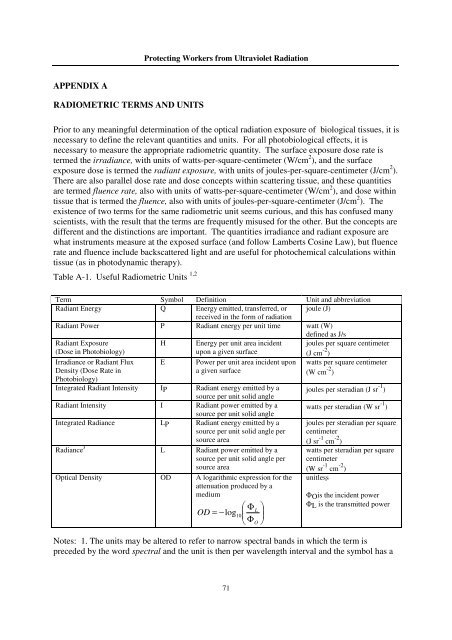Protecting Workers from Ultraviolet Radiation - icnirp
Protecting Workers from Ultraviolet Radiation - icnirp
Protecting Workers from Ultraviolet Radiation - icnirp
You also want an ePaper? Increase the reach of your titles
YUMPU automatically turns print PDFs into web optimized ePapers that Google loves.
APPENDIX A<br />
RADIOMETRIC TERMS AND UNITS<br />
<strong>Protecting</strong> <strong>Workers</strong> <strong>from</strong> <strong>Ultraviolet</strong> <strong>Radiation</strong><br />
Prior to any meaningful determination of the optical radiation exposure of biological tissues, it is<br />
necessary to define the relevant quantities and units. For all photobiological effects, it is<br />
necessary to measure the appropriate radiometric quantity. The surface exposure dose rate is<br />
termed the irradiance, with units of watts-per-square-centimeter (W/cm 2 ), and the surface<br />
exposure dose is termed the radiant exposure, with units of joules-per-square-centimeter (J/cm 2 ).<br />
There are also parallel dose rate and dose concepts within scattering tissue, and these quantities<br />
are termed fluence rate, also with units of watts-per-square-centimeter (W/cm 2 ), and dose within<br />
tissue that is termed the fluence, also with units of joules-per-square-centimeter (J/cm 2 ). The<br />
existence of two terms for the same radiometric unit seems curious, and this has confused many<br />
scientists, with the result that the terms are frequently misused for the other. But the concepts are<br />
different and the distinctions are important. The quantities irradiance and radiant exposure are<br />
what instruments measure at the exposed surface (and follow Lamberts Cosine Law), but fluence<br />
rate and fluence include backscattered light and are useful for photochemical calculations within<br />
tissue (as in photodynamic therapy).<br />
Table A-1. Useful Radiometric Units 1,2<br />
Term Symbol Definition Unit and abbreviation<br />
Radiant Energy Q Energy emitted, transferred, or<br />
received in the form of radiation<br />
joule (J)<br />
Radiant Power P Radiant energy per unit time watt (W)<br />
defined as J/s<br />
Radiant Exposure<br />
H Energy per unit area incident joules per square centimeter<br />
(Dose in Photobiology)<br />
upon a given surface<br />
(J cm -2 )<br />
Irradiance or Radiant Flux E Power per unit area incident upon watts per square centimeter<br />
Density (Dose Rate in<br />
Photobiology)<br />
a given surface<br />
(W cm -2 )<br />
Integrated Radiant Intensity IP Radiant energy emitted by a<br />
source per unit solid angle<br />
joules per steradian (J sr -1 )<br />
Radiant Intensity I Radiant power emitted by a<br />
source per unit solid angle<br />
watts per steradian (W sr -1 )<br />
Integrated Radiance LP Radiant energy emitted by a<br />
source per unit solid angle per<br />
joules per steradian per square<br />
centimeter<br />
source area<br />
(J sr -1 cm -2 )<br />
Radiance 3 L Radiant power emitted by a watts per steradian per square<br />
source per unit solid angle per centimeter<br />
source area<br />
(W sr -1 cm -2 )<br />
Optical Density OD A logarithmic expression for the<br />
attenuation produced by a<br />
unitless<br />
medium<br />
ΦOis the incident power<br />
ΦL is the transmitted power<br />
OD = −log<br />
10<br />
Notes: 1. The units may be altered to refer to narrow spectral bands in which the term is<br />
preceded by the word spectral and the unit is then per wavelength interval and the symbol has a<br />
71<br />
Φ<br />
Φ<br />
L<br />
O



